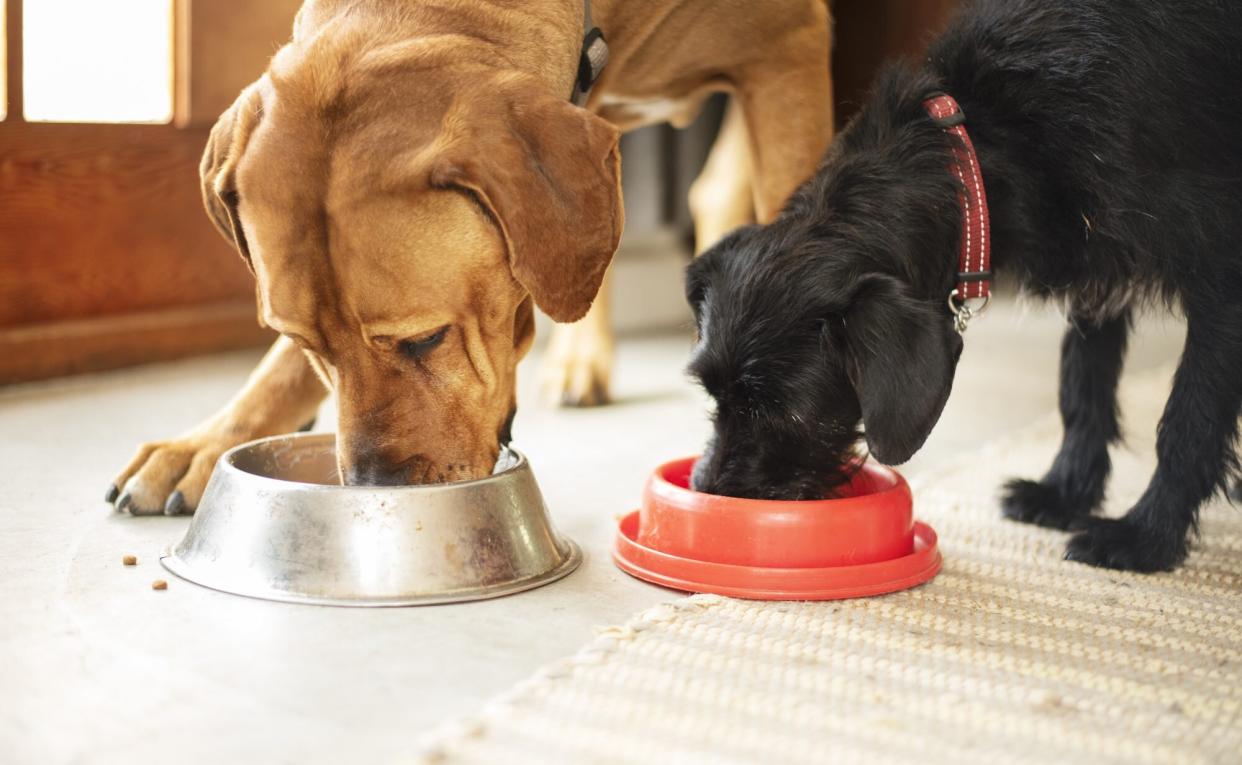Wet vs. Dry Dog Food: Which Should You Feed Your Dog?

NickyLloyd / Getty Images
TABLE OF CONTENTS
On This Page
Differences
Which Is Better?
Feeding Both
Dental Benefits
Cost
How to Switch
Whether you're a first-time or experienced pet parent, deciding between wet versus dry dog food can be a little tricky to figure out. With what seems like endless dog food varieties out there, it's easy to wonder, "Is wet food better than dry food for dogs? Or, is dry? … Or, do dogs need wet and dry food?"
Ultimately, what you choose to feed your dog depends on their individual needs (age, size, activity level) and preference. It's always best to consult your vet for diet recommendations specifically tailored to your dog, but here's a rundown of the pros and cons of wet dog food and dry dog food to help jump-start your decision.
Differences Between Wet and Dry Dog Food
Wet and dry foods are processed to have vastly different textures and can thus vary in nutritional and moisture content. Despite these differences, the Merck Veterinary Manual states wet and dry dog food both provide the same nutrition.
Linda Simon, DVM, MVB, and MRCVS, and veterinarian at Senior Tail Waggers, says most dogs, particularly smaller breeds and picky eaters, prefer wet food. Because wet food contains lots of moisture, she says it's great for dogs with kidney or bladder stones. However, a few drawbacks of wet food, Simon adds, is that it can be a little messier and go bad quicker, especially when left out in the heat.
Meanwhile, dry food also has its benefits, such as being convenient, not spoiling as quickly due to its processing, and being good for dogs' teeth. Although, some dogs might prefer wet food's taste and texture over dry food.
Is It Better for Dogs to Eat Wet or Dry Food?
Simon says while pet parents can mix feed, which provides "the best of both worlds," dogs prone to urinary issues or dehydration should be given wet food. Dry food, on the hand—er, paw—may be a better choice for dogs with a history of dental disease or smaller dogs with overcrowded mouths.
RELATED: Everything You Need to Know About Puppy Feeding
Wet Food Pros
Advantages of feeding wet food, Simon says, include that it's:
Highly palatable
High in moisture
Often contains more protein and fewer carbohydrates than dry food
Wet Food Cons
Drawbacks of wet food include that it:
Can get messy on long-haired dogs
Spoils quickly when left out
Takes up more storage space in the home
Dry Food Pros
Pros of feeding dry food, Simon says, include that it:
Leaves little mess behind (on both the bowl and the dog)
Tends to be more affordable than wet food
Can help prevent dental disease
Dry Food Cons
A few dry food cons include that it:
Isn't as palatable for dogs
Can have too many carbohydrates (which can contribute to obesity) depending on the formulation
Doesn't contain much moisture, so it may not be a good option for dogs who don't drink much water
Should You Feed Your Dog Both Wet Food and Dry Food?
Whether you should feed your dog a mix of wet and dry food is entirely up to you and your dog's preference, as feeding one or the other is just fine too, Simon says. She explains that many pet parents like to mix feed considering the benefits—and not to mention, affordability—of dry food, while dogs enjoy the taste of wet food.
"If mixed feeding, it is best for dental hygiene to offer the kibble after the wet food," Simon advises. "However, some dogs have a strong wet food preference, so [they] would just refuse the kibble if this is done. For these dogs, mixing the food well in the same bowl is best."
RELATED: How Much Food Does Your Dog Really Need?
Does Dry Food Clean Dogs' Teeth?
There are special dental diets that can help minimize buildup on the teeth and even remove plaque due to the abrasive action of the kibble, Simon says. And while this may be ever so slightly beneficial, she says the best way to clean your dog's teeth is daily tooth brushing.
What's the Cost of Wet vs. Dry Dog Food?
Simon explains that we're unable to compare weight for weight between wet and dry dog food since wet food contains about 80 percent water. Between the two, she says dry food can be bought in bulk and is usually cheaper, whereas wet food can cost up to $1 more per day than dry depending on the diet offered and the size of the dog.
For example, Chewy's website shows an 8-pound bag of Purina One dry food is about $16, or $2 per pound. Meanwhile, a 12 pack of Purina's 13 ounce canned food is about $19, equivalent to $0.12 per ounce.
How to Switch from Dry Dog Food to Wet Dog Food—Or Vice Versa
"Any diet change needs to be made gradually over 4–5 days to avoid stomach upset," Simon says. "A 'straight swap' will likely be refused and can cause diarrhea, bloating, and vomiting."
She adds that switching from wet food to dry can be trickier since dogs may not like the taste initially. In these cases, she recommends not "giving in" and giving them other foods since they may learn that refusing their kibble "earns" them tastier food. And as always, consult with your vet before making the switch to make sure it's the right choice for your dog.
Bon appétit!

